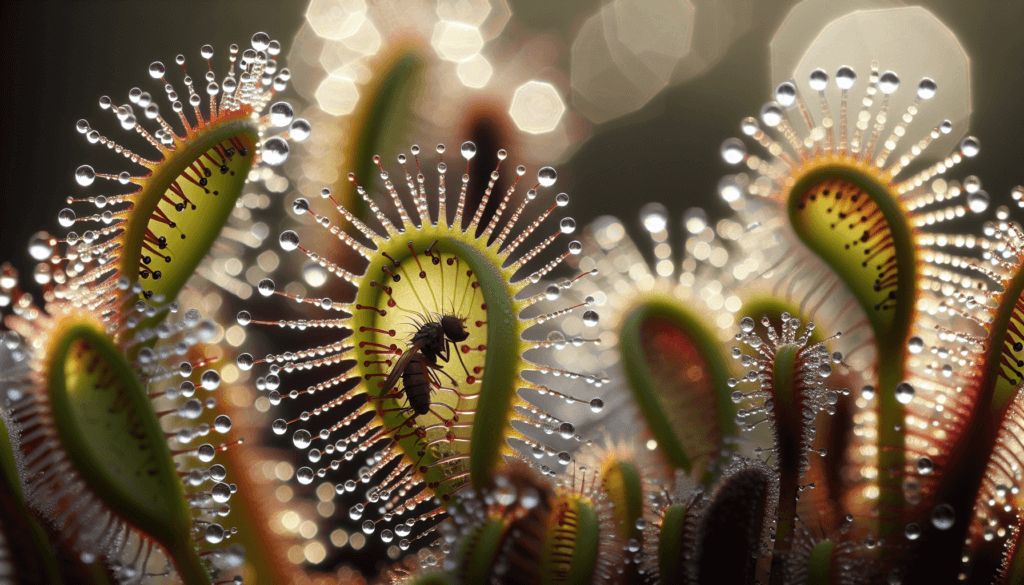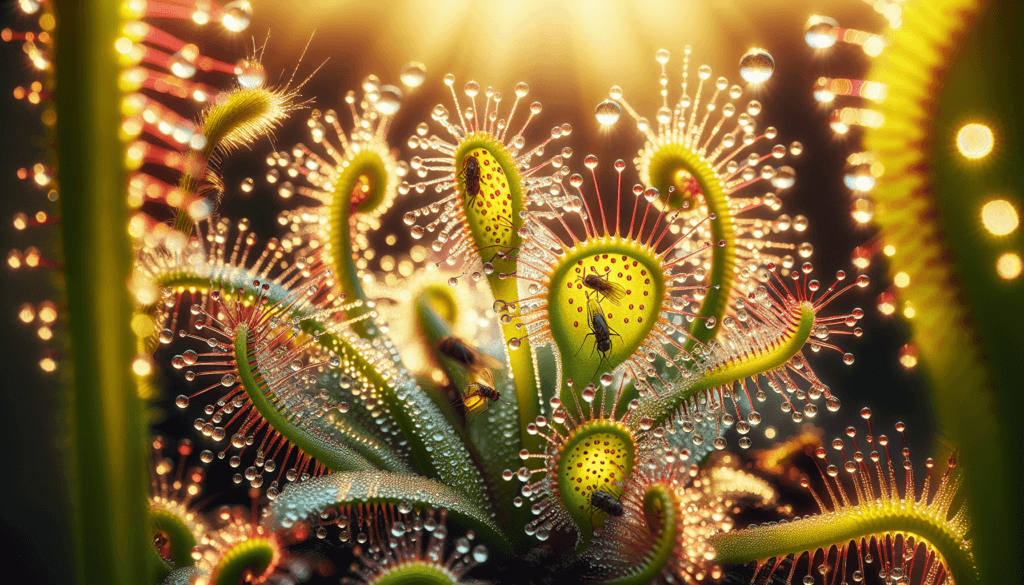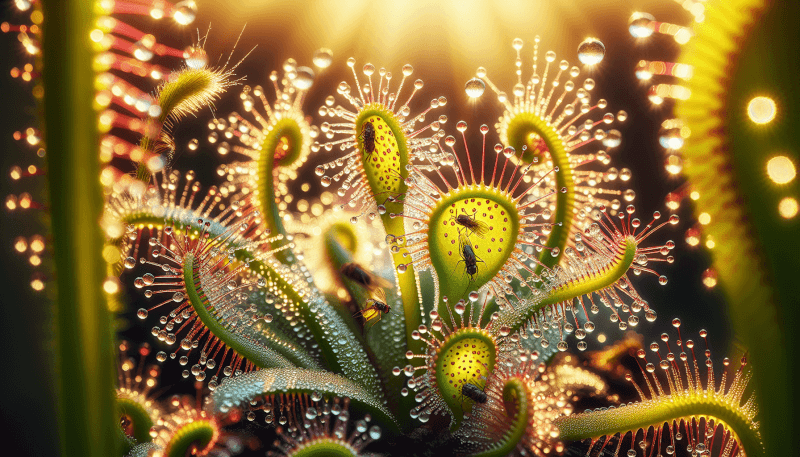If you’re looking to add a dose of intrigue to your plant collection, look no further than the fascinating sundew plant. Known for its unique appearance and carnivorous nature, the sundew plant is a captivating addition to any indoor garden. In this article, you’ll discover the secrets to successful sundew plant care, from providing the right environment to feeding these tiny insect-killers. So get ready to dive into the world of sundew plants and unlock the secrets to keeping these captivating carnivores thriving in your home.

Choosing a Sundew Plant
When it comes to choosing a Sundew plant, there are a few considerations to keep in mind. Firstly, you will need to decide on the specific variety of Sundew plant you want to grow. Popular varieties include the Drosera capensis, Drosera spatulata, and Drosera filiformis.
Once you have decided on the variety, you will need to consider the size of the plant and whether it is suitable for your available space. Some sundew plants can grow quite large, while others are more compact and suitable for smaller areas.
Another important factor to consider is the level of care required for the specific variety. Some Sundew plants are relatively easy to care for and are great for beginners, while others may require more attention and experience. Take into consideration your level of expertise and available time for plant care before making your selection.
Sunlight Requirements
Understanding the light needs of Sundew plants is crucial for their healthy growth. Sundews are typically native to areas with ample sunlight, such as bogs and marshes. As such, they thrive in bright, indirect sunlight.
When providing sunlight for your Sundew plant, it is essential to strike a balance. While they require a good amount of light, they are also sensitive to intense, direct sunlight. Placing your Sundew plant near a north-facing window is often an ideal location as it provides bright but indirect sunlight.
If you don’t have access to a suitable window, you can also use artificial grow lights to supplement the natural light. Just ensure that the light source is not too close to the plant, as too much heat can damage the Sundew.
Watering
Determining the right watering routine for Sundew plants is crucial to their overall health and well-being. Sundews require a moist environment, as they are adapted to grow in boggy, water-rich areas.
One common mistake in watering Sundews is overwatering. While they do require moist soil, it is important not to let them sit in standing water, as this can lead to root rot and other issues. Instead, water your Sundew plant by placing its pot in a shallow tray filled with water, allowing the plant to absorb the moisture from the bottom.
Another important aspect of watering Sundew plants is the type of water used. Tap water often contains minerals and chemicals that may harm the plant over time. It is best to use distilled or rainwater, as they are free from impurities that could be detrimental to the plant’s health.

Soil and Potting
Selecting the appropriate soil for Sundew plants is essential for their success. Sundews thrive in a nutrient-poor substrate, as they obtain their nutrients from trapping and digesting insects. A mixture of sphagnum moss and perlite or sand is often a suitable choice for Sundew plants.
When potting Sundews, it is crucial to choose a container that provides adequate drainage. Sundews do not tolerate waterlogged soil, so ensuring that excess water can easily escape the pot is essential. A plastic or ceramic pot with drainage holes is often the best option.
Repotting Sundew plants should be done when necessary, typically when the plant has outgrown its current container or if the soil has become overly compacted. Remember to handle the delicate roots carefully during the repotting process to avoid any damage.
Temperature and Humidity
Sundew plants have specific temperature and humidity requirements to thrive. Generally, they prefer mild to warm temperatures, ranging from 60 to 80 degrees Fahrenheit (15 to 27 degrees Celsius).
Maintaining the appropriate humidity level is crucial for the health of Sundew plants. They require high humidity to mimic their natural habitat. To increase humidity, you can place a tray of water near the plant or use a humidifier. Additionally, grouping Sundews together can create a microclimate with higher humidity.
To provide optimal temperature and humidity levels, it is important to monitor your Sundew plant’s environment closely. Investing in a thermometer and hygrometer can help you keep track of these essential conditions.
Feeding Sundew Plants
Sundews are carnivorous plants, and understanding their feeding habits is essential for their overall health and well-being. Sundews capture and digest insects to obtain nutrients that are lacking in their natural environment.
When it comes to feeding Sundew plants, it is important to choose the right prey. Small insects such as fruit flies, gnats, and aphids are typically suitable choices. Avoid feeding your Sundew large insects that may not fit within the plant’s capabilities to catch and digest.
Feeding techniques for Sundew plants vary depending on the type of Sundew and the size of the prey. Some Sundews have sticky tentacles that trap insects upon contact, while others utilize active movement to ensnare their prey. It is important to observe your Sundew’s natural feeding behavior and adjust the feeding process accordingly.
It is worth noting that while Sundews can catch their own prey, supplemental feeding may be necessary, especially if they are grown indoors or if their natural environment lacks an adequate insect population.
Pruning and Propagation
Pruning plays an important role in maintaining healthy Sundew plants. Regular pruning helps remove dead or decaying leaves, improves airflow, and stimulates growth. When pruning Sundews, use sterilized pruning shears to prevent the spread of any diseases or infections.
Propagation is another way to expand your collection of Sundew plants. Sundews can be propagated through various methods, such as leaf cuttings, division of rhizomes, or by collecting and sowing seeds. Each method has its advantages and challenges, and it is essential to research and understand the specific requirements of your chosen propagation method.
When propagating Sundews, it is important to provide the appropriate environmental conditions, such as high humidity and optimal temperature. Patience is key, as propagation can take some time, but it is a rewarding process that allows you to create new plants from your existing ones.
Pest Control
Despite their carnivorous nature, Sundew plants can still be susceptible to pests. Common pests that affect Sundews include aphids, fungus gnats, and spider mites. It is important to identify any pest infestations early and take appropriate measures to control and eradicate them.
Natural pest control methods can be effective in managing pest infestations on Sundew plants. For example, introducing predatory insects such as ladybugs or using sticky traps can help control aphids and gnats. Additionally, maintaining a clean and hygienic environment around the plants can help prevent pest infestations.
In severe cases, chemical pest control methods may be necessary. However, it is essential to choose pesticides specifically formulated for use on carnivorous plants and to follow the instructions carefully to avoid harming the Sundews.
Dormancy Period
Understanding the dormancy requirements of Sundew plants is crucial for their long-term health. Dormancy is a natural period of rest that allows Sundews to conserve energy and prepare for the upcoming growing season.
Most Sundews enter a dormancy period during the winter months when daylight hours are shorter and temperatures drop. During this period, Sundews may appear dormant, with leaves yellowing or dying back. It is important not to mistake dormancy for poor health, as it is an essential part of their natural growth cycle.
To prepare your Sundews for dormancy, gradually reduce watering and provide them with cooler temperatures and lower light levels. Place them in a cool location, such as a basement or a windowsill away from direct sunlight. It is important to avoid watering your dormant Sundew plants to prevent root rot.
Troubleshooting
Caring for Sundew plants can sometimes pose challenges, but knowing how to troubleshoot common issues can help you address problems promptly. Some signs of stress in Sundew plants include wilting leaves, discoloration, and lack of growth.
If you notice wilting leaves, it may indicate either underwatering or overwatering. Adjust your watering routine accordingly and ensure the soil is consistently moist but not waterlogged.
Discoloration of leaves can be a sign of nutrient deficiency or exposure to extreme temperatures. Evaluate your plant’s environment and consider adjusting the soil mix or relocating the plant to a more suitable location.
Lack of growth or stunted growth may be a result of inadequate light or poor nutrient availability. Assess the amount and quality of light your Sundew is receiving and consider supplementing its feeding with small insects.
By paying close attention to your Sundew plants and promptly addressing any issues, you can ensure their continued health and enjoy their unique beauty for years to come.
In conclusion, caring for a Sundew plant involves considering factors such as variety selection, sunlight requirements, watering routines, soil and potting techniques, temperature and humidity levels, feeding habits, pruning and propagation methods, pest control, dormancy requirements, and troubleshooting common issues. With proper care and attention, your Sundew plants will thrive and provide you with a fascinating and carnivorous addition to your indoor or outdoor garden.

